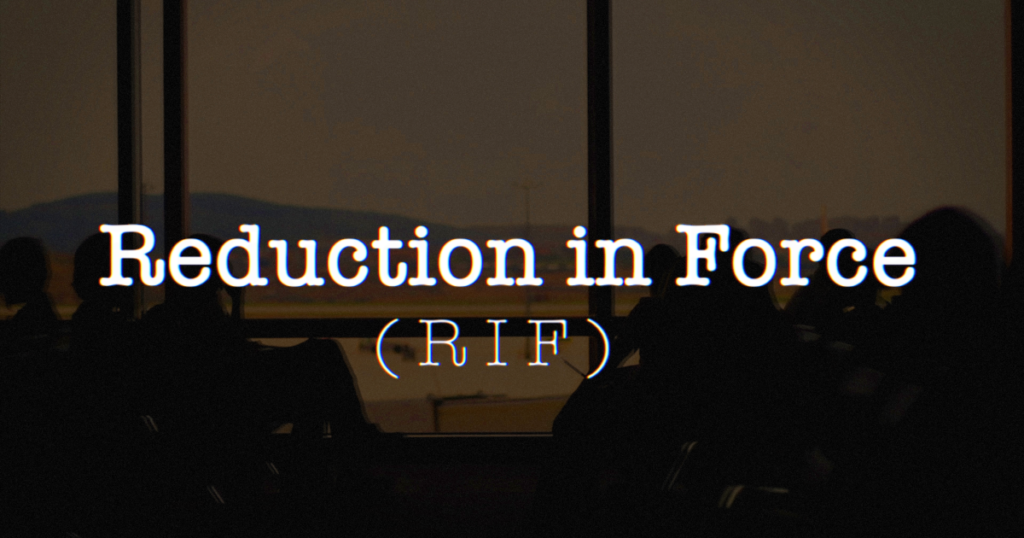Introduction
Reduction in Force (RIF) is a challenging and often emotionally charged event for both employees and employers. It involves the deliberate downsizing of an organization’s workforce for various reasons, such as cost reduction, structural optimization, or adapting to changing business needs. In this article, we will explore the essential aspects of a Reduction in Force, providing insights into what employees and employers should expect and how to navigate this challenging process.
Notification and Termination
When an agency decides to implement a Reduction in Force, employees should expect to receive formal notification from their employer. This notification may come in the form of a meeting or a letter, explaining the reasons behind the decision and how it will affect individual employees. In most cases, affected employees will face termination or layoff from their current positions, meaning they will no longer be employed by the agency after a specified date.
Severance Packages
To ease the transition for employees, some employers may offer a severance package. This package often includes financial compensation, extended healthcare benefits, and other perks. The specifics of these packages can vary widely depending on the State policy and the employee’s length of service. Severance packages aim to provide employees with a financial safety net during their job search.
Notice Period
In some cases, employees may be asked to work a notice period before their employment officially ends. During this time, they may be expected to train their replacements, complete outstanding projects, or help with the transition process. The length of the notice period can vary and is typically determined by the employer’s needs and policies.
Outplacement Services
Many employers provide outplacement services to help affected employees find new job opportunities. These services can include resume assistance, job search support, and career counseling. Outplacement services demonstrate a commitment to supporting employees’ future career endeavors, even after a RIF.
Unemployment Benefits
Depending on the circumstances and local laws, employees may be eligible for unemployment benefits. These benefits can provide financial support during their job search, helping to bridge the gap between their previous employment and finding a new position.
Return of State Property
Employees affected by a RIF will likely need to return any State-owned property, such as laptops, badges, or equipment, at the end of their employment. This is a standard procedure to ensure the state’s assets are accounted for.
References and Recommendations
Before leaving the Agency, it’s advisable for employees to request references or letters of recommendation from their supervisors or colleagues. These references can be valuable when seeking new employment opportunities and can attest to an individual’s skills and work ethic.
Legal Rights
Employees should be aware of their legal rights when facing a RIF. If they believe their termination is unfair or discriminatory, consulting with OPEA a prudent step. Understanding and asserting their rights is essential for safeguarding their interests.
Emotional Support
Facing a reduction in force can be emotionally challenging. The uncertainty surrounding job loss, financial security, and career prospects can take a toll on mental well-being. Employees should seek support from friends, family, or professional counselors to help them cope with the stress and emotional impact of a RIF.
Employer’s Perspective
From an employer’s perspective, implementing a RIF is a strategic decision aimed at ensuring the long-term viability and competitiveness of the organization. This decision is not taken lightly and often involves careful planning and analysis.
Planning and Analysis
Before implementing a RIF, organizations engage in a thorough planning and analysis phase. This includes assessing the current workforce, identifying areas where reductions are necessary, and estimating the financial impact of the RIF. This data-driven approach ensures that the RIF is carried out efficiently and effectively.
Legal and Compliance Considerations
Employers must comply with applicable labor laws and regulations during a RIF. Violating labor laws can lead to legal consequences. Legal considerations may include adherence to the Worker Adjustment and Retraining Notification (WARN) Act requirements and compliance with state policy.
Communication
Effective communication is crucial during a RIF. Employers should communicate the reasons for the RIF, the criteria used for employee selection, and any support services available to affected employees. Transparency and empathy are key to maintaining employee morale and trust during this challenging time.
Conclusion
Reduction in Force is a complex and challenging process that affects both employees and employers. It is a strategic decision made to ensure an organization’s long-term viability and competitiveness. Effective communication, adherence to legal requirements, and support for affected employees are crucial elements in navigating a RIF successfully. By understanding the process and rights involved, employees and employers can work together to minimize the impact of a RIF and facilitate a smoother transition for all parties involved.




